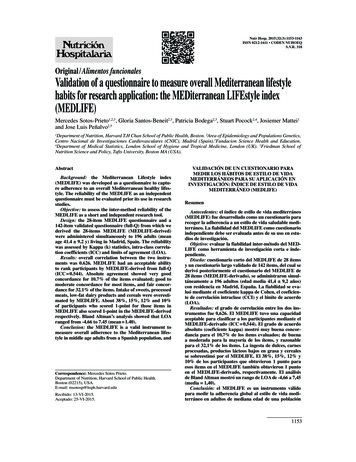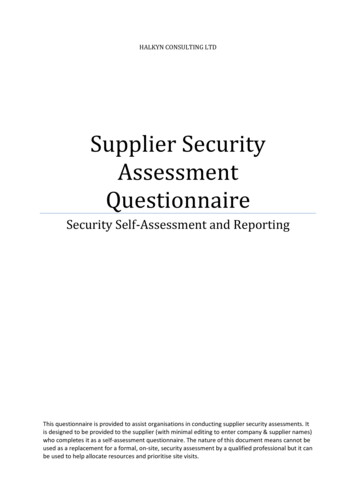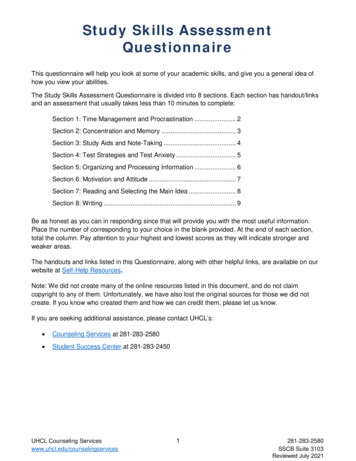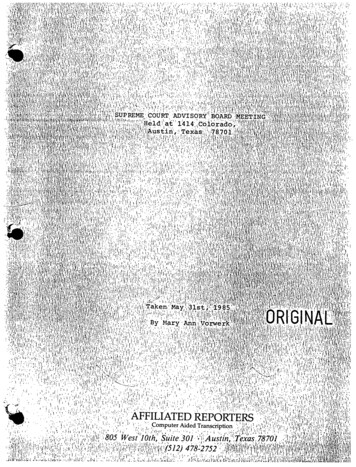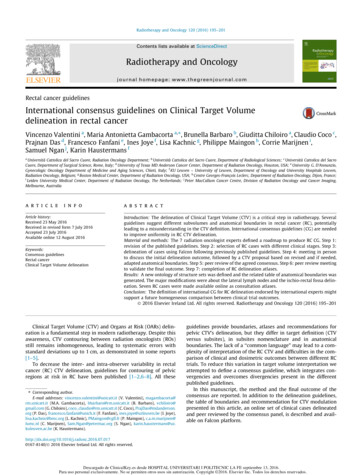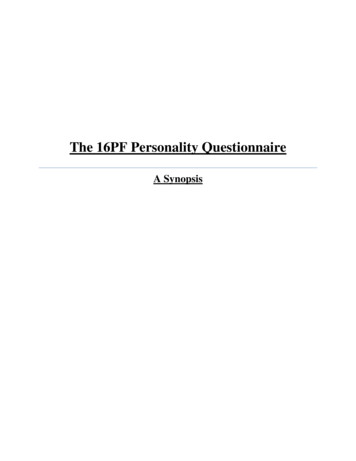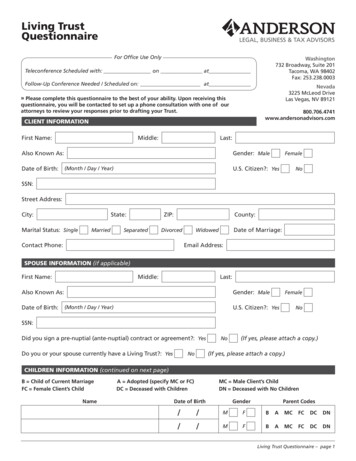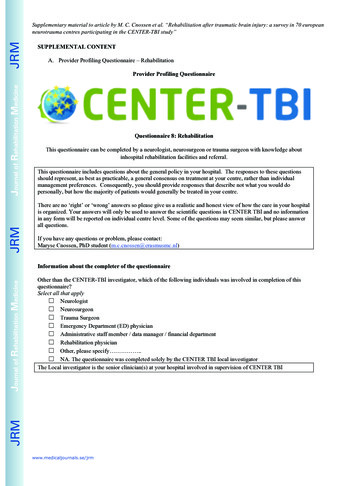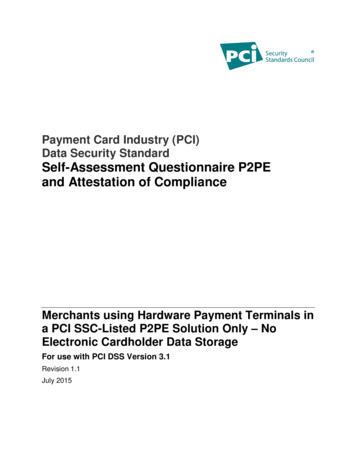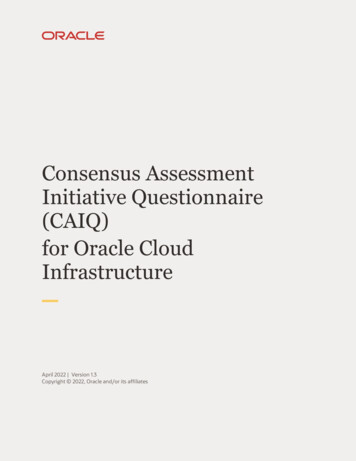
Transcription
Consensus AssessmentInitiative Questionnaire(CAIQ)for Oracle CloudInfrastructureApril 2022 Version 1.3Copyright 2022, Oracle and/or its affiliates
PURPOSE STATEMENTDeveloped by the Cloud Security Alliance, the Cloud Assessment Initiative Questionnaire (CAIQ) provides a standardtemplate for cloud services provider to accurately describe their security practices. The CAIQ format is largely based on theCloud Controls Matrix (CCM), which lists a set of fundamental cloud controls. The use of CAIQs allow customers to reviewthe security practices of their cloud services providers to determine the risks associated with the use of these services.Additional information about the CCM and CAIQ can be found on the Cloud Security Alliance site and downloaded acts/.The answers contained in this CAIQ version 3.1 are related to specific Oracle cloud services as listed in the “Oracle CloudServices in Scope” section below.The Oracle Corporate Security site provides additional information and is referenced in the CAIQ answers throughout thisdocument. This site is available to the public: s/.If you have specific questions about this document, please engage with your Oracle account representative.DISCLAIMERThis document (including responses related to the specified Oracle services) is provided on an “AS IS” basis withoutwarranty of any kind and is subject to change without notice at Oracle's discretion. You may use this document (includingresponses related to the specified Oracle services) for informational purposes only to assist in your internal evaluation of thespecified Oracle services. This document does not create, nor form part of or modify, any agreement or contractualrepresentation between you and Oracle, or the Oracle authorized reseller, as applicable. In the event you purchase Oracleservices, the relevant contract(s) between you and Oracle, or the Oracle authorized reseller, as applicable, will determine thescope of services provided and the related governing terms and conditions. Oracle and its licensors retain all ownership andintellectual property rights in and to this document and its contents, and you may not remove or modify any markings orany notices included herein of Oracle’s or its licensors’ proprietary rights.It remains solely your obligation to determine whether the controls provided by the Oracle services meet your requirements.Please also note that any Yes/No responses, and any computed "In Place" indicators, must be read in the context of thesupplied comments and qualifications, and, given the diversity and complexity of the services, will not be absolute orapplicable in all instances. The explanation and/or supporting documentation comprise Oracle’s response and controlregardless of the scoring or any Yes/No response. The responses provided in this document apply solely to the servicesspecifically listed and other products or services may have different controls.1CAIQ for Oracle Cloud Infrastructure Version 1.3
ORACLE CLOUD SERVICES IN SCOPEOracle Cloud Infrastructure (OCI) is a set of complementary cloud services that enable you to build and run a wide range ofapplications and services in a highly available and secure hosted environment. OCI offers high-performance computingcapabilities and storage capacity in a flexible overlay virtual network that is easily accessible from an on-premises network.OCI also delivers high-performance computing power to run cloud native and enterprise IT workloads. For more informationabout OCI, see m.The answers provided in this document are for the architecture, boundaries, and components underlying Oracle CloudInfrastructure. These answers are provided in the same context as the Cloud Security Alliance Security, Trust, Assuranceand Risk (CSA STAR) based on criteria to assess the Cloud Control Matrix (CCM) Version 3.1.The scope is applicable to the following Oracle services:Accounts ManagementData IntegrationLoad BalancingAnalytics CloudData LabelingLoggingAnomaly DetectionData SafeLogging AnalyticsAPI GatewayData ScienceManagement AgentApplication PerformanceMonitoringData TransferMarketplace – ConsumerDatabase ManagementMonitoringArchive StorageDatabase MigrationMySQL DatabaseArtifact RegistryDatabase ToolsNetwork Load BalancerAuditDistributed Denial of Service(DDoS) ProtectionNetworkingDevOps – Build ServiceNotificationsAutonomous Database on Cloudat CustomerAutonomous Database onDedicated Exadata InfrastructureAutonomous Database on SharedExadata InfrastructureBare Metal and Virtual MachineDatabase SystemsBastionBlock VolumeBlockchain PlatformCertificatesClassic MigrationCloud AdvisorCloud GuardCloud ShellComputeConsole AnnouncementsContainer Engine for KubernetesContent ManagementData CatalogData Flow2CAIQ for Oracle Cloud Infrastructure Version 1.3DevOps – Deployment PipelinesNoSQL DatabaseObject StorageDevOps – Project ServiceOperational InsightsDevOps – Source CodeManagementOperator Access ControlDigital AssistantEmail DeliveryEventsExadata Cloud at CustomerExadata Cloud ServiceFastConnectFile StorageFunctionsFusion Analytics WarehouseGoldenGateHealth ChecksIdentity and Access Management(IAM)IntegrationJava ManagementLanguageOS ManagementRegistryResource ManagerSearchSecurity ZonesService Connector HubSpeechStreamingTaggingThreat Intelligence ServiceVaultVisionVMWare SolutionVPN ConnectVulnerability ScanningWeb Application Firewall
Located in the following regions, availability domains and points of presence:Commercial RegionsAustralia East (Sydney)Netherlands Northwest (Amsterdam)Australia Southeast (Melbourne)Saudi Arabia West (Jeddah)Brazil East (Sao Paulo)Singapore (Singapore)Brazil Southeast (Vinhedo)South Africa Central (Johannesburg)Canada Southeast (Montreal)South Korea (Chuncheon)Canada Southeast (Toronto)Sweden Central (Stockholm)Chile Central (Santiago)Switzerland North (Zurich)France South (Marseille)UAE East (Dubai)Germany Central (Frankfurt)UAE Central (Abu Dubai)India South (Hyderabad)UK South (London)India West (Mumbai)UK West (Newport)Israel Central (Jerusalem)US East (Ashburn)Italy Northwest (Milan)US West (Phoenix)Japan Central (Osaka)US West (San Jose)Japan East (Tokyo)Government regionsUnited Kingdom Government South (London)United States Department of Defense West: (Phoenix)United Kingdom Government West: (Newport)United States Government East (Ashburn)United States Department of Defense East: (Ashburn)United States Government West (Phoenix)United States Department of Defense North (Chicago)Office facilities and security/network operating centers:Bangalore, IndiaKaunas, LithuaniaDublin, IrelandNashua, New Hampshire, United StatesHyderabad, IndiaSeattle, Washington, United States3CAIQ for Oracle Cloud Infrastructure Version 1.3
TABLE OF CONTENTSPurpose Statement1Disclaimer1Oracle Cloud Services in Scope2Consensus Assessment Initiative Questionnaire (CAIQ)54CAIQ for Oracle Cloud Infrastructure Version 1.3
CONSENSUS ASSESSMENT INITIATIVE QUESTIONNAIRE (CAIQ)Control DomainQuestion IDConsensus Assessment QuestionOracle ResponseApplication & InterfaceSecurity:AIS-01.1Do you use industry standards (i.e.OWASP Software AssuranceMaturity Model, ISO 27034) tobuild in security for yourSystems/Software DevelopmentLifecycle (SDLC)?Encompassing every phase of the product development lifecycle, Oracle SoftwareSecurity Assurance (OSSA) is Oracle’s methodology for building security into thedesign, build, testing, and maintenance of its products, whether they are used onpremises by customers, or delivered through Oracle Cloud. Oracle’s goal is to ensurethat Oracle’s products help customers meet their security requirements whileproviding for the most cost-effective ownership experience.Application SecurityTo ensure that Oracle products are developed with consistently high securityassurance, and to help developers avoid common coding mistakes, Oracle employsformal secure coding standards.For more information, see /assurance/AIS-01.2Do you use an automated sourcecode analysis tool to detectsecurity defects in code prior toproduction?Security testing of Oracle code includes both functional and non-functional activitiesfor verification of product features and quality. Although these types of tests oftentarget overlapping product features, they have orthogonal goals and are carried outby different teams. Functional and non-functional security tests complement eachother to provide comprehensive security coverage of Oracle products.Static security analysis of source code is the initial line of defense used during theproduct development cycle. Oracle uses a static code analyzer from Fortify Software,an HP company, as well a variety of internally developed tools, to catch problemswhile code is being written. Products developed in most modern programminglanguages (such as C/C , Java, and C #) and platforms (J2EE, .NET) are scanned toidentify possible security issues.For more information, see .3Do you use manual source-codeanalysis to detect security defectsin code prior to production?Oracle Developers use static and dynamic analysis tools to detect security defects inOracle code prior to production. Identified issues are evaluated and addressed inorder of priority and severity. Oracle management tracks metrics regarding issueidentification and resolution.For more information, see .45CAIQ for Oracle Cloud Infrastructure Version 1.3Do you verify that all of yoursoftware suppliers adhere toindustry standards forOracle Software Security Assurance (OSSA) policies require that third-partycomponents (e.g., open source components used in the Oracle Clouds or distributedin traditional Oracle product distributions) be appropriately assessed for securitypurposes. Additionally, Oracle has formal policies and procedures which define
Control DomainQuestion IDConsensus Assessment QuestionOracle ResponseSystems/Software DevelopmentLifecycle (SDLC) security?requirements for managing the safety of its supply chain, including how Oracleselects third-party hardware and software that may be embedded in Oracle products,as well as how Oracle assesses third-party technology used in Oracle’s corporate andcloud environments.For more information, see /corporate/supply-chain/AIS-01.5(SaaS only) Do you review yourapplications for securityvulnerabilities and address anyissues prior to deployment toproduction?Not applicable to OCI. However, generally speaking, Corporate Security Architecturemanages a variety of programs and leverages multiple methods of engaging withleadership and operational security teams responsible for Oracle operations, services,cloud, and all other lines of business. An example program for managing the securityof Oracle’s architecture is the Corporate Security Solution Assurance Process (CSSAP).CSSAP helps to accelerate the delivery of innovative cloud solutions and corporateapplications by requiring appropriate reviews to be carried out throughout the projectlifecycle, so that projects are aligned with:Pre-review: the risk management teams in each line of business must perform a preassessment of each project using the approved templateCSSAP review: the security architecture team reviews the submitted plans andperforms a technical security design reviewSecurity assessment review: based on risk level, systems and applications undergosecurity verification testing before production useApplication & InterfaceSecurity:AIS-02.1Are all identified security,contractual, and regulatoryrequirements for customer accesscontractually addressed andremediated prior to grantingcustomers access to data, assets,and information systems?See Oracle Cloud Services Contracts and Cloud Delivery Policies documents tounderstand how Oracle will deliver Cloud s/cloud-services/AIS- 02.2Are all requirements and trustlevels for customers’ accessdefined and documented?Customers are responsible for establishing and implementing trust levels for access totheir environment, and should be considered during the provisioning process. Formore information on setting up your tenancy, see: epts/settinguptenancy.htmAIS-03.1Does your data managementpolicies and procedures requireaudits to verify data input andoutput integrity routines?Oracle Secure Coding Standards are a roadmap and guide for developers in theirefforts to produce secure code. They discuss general security knowledge areas suchas design principles, cryptography and communications security, commonvulnerabilities, etc. The Standards provide specific guidance on topics such as datavalidation, CGI, user management, and more.Customer AccessRequirementsApplication & InterfaceSecurity:Data Integrity6CAIQ for Oracle Cloud Infrastructure Version 1.3Customer remains solely responsible for its regulatory compliance in its use of anyOracle Cloud services. Customer must make Oracle aware of any requirements thatresult from its regulatory obligations prior to contract signing.
Control DomainQuestion IDConsensus Assessment QuestionOracle ResponseAll Oracle developers must be familiar with these standards and apply them whendesigning and building products. The coding standards have been developed over anumber of years and incorporate best practices as well as lessons learned fromcontinued vulnerability testing by Oracle’s internal product assessment team.For more information, see /assurance/development/AIS-03.2Are data input and output integrityroutines (i.e. MD5/SHAchecksums) implemented forapplication interfaces anddatabases to prevent manual orsystematic processing errors orcorruption of data?Cloud Infrastructure (OCI) are required to follow Oracle Software Security Assuranceand conform to its secure coding standards. These standards provide guidance forvarious issues including overflow and injection prevention, sensitive informationprotection, as well as input and output validation. For more information on the OracleSoftware Security Assurance process, ex.htmlNote that customers can operate a wide range of workload on OCI and need to ensurethat similar mechanisms exist on the systems they operate.Application & InterfaceSecurity:AIS-04.1Data Security /IntegrityIs your Data Security Architecturedesigned using an industrystandard (e.g., CDSA, MULITSAFE,CSA Trusted Cloud ArchitecturalStandard, FedRAMP, CAESARS)?The Oracle corporate security architect helps set internal information-securitytechnical direction and guides Oracle’s IT departments and lines of business towardsdeploying information security and identity management solutions that advanceOracle's Information Security goals. An example program for managing the security ofOracle’s architecture is the Corporate Security Solution Assurance Process (CSSAP).CSSAP is a security review process developed by Corporate Security Architecture,Global Information Security, Global Product Security, Oracle Global IT, and Oracle's ITorganizations to provide comprehensive information-security management review.CSSAP helps to accelerate the delivery of innovative cloud solutions and corporateapplications by requiring appropriate reviews to be carried out throughout the projectlifecycle, so that projects are aligned with:Pre-review: the risk management teams in each line of business must perform a preassessment of each project using the approved templateCSSAP review: the security architecture team reviews the submitted plans andperforms a technical security design reviewSecurity assessment review: based on risk level, systems and applications undergosecurity verification testing before production useAudit Assurance &Compliance:AAC-01.1Audit Planning7CAIQ for Oracle Cloud Infrastructure Version 1.3Do you develop and maintain anagreed upon audit plan (e.g.,scope, objective, frequency,resources, etc.) for reviewing theOCI operates under policies, which are generally aligned with the ISO/IEC 27002 Codeof Practice for information security controls. The internal controls of Oracle CloudInfrastructure are subject to periodic testing by independent third-party auditorganizations. Such audits may be based on the Statement on Standards forAttestation Engagements (SSAE) 18, Reporting on Controls at a Service Organization
Control DomainAudit Assurance &Compliance:Question IDConsensus Assessment QuestionOracle Responseefficiency and effectiveness ofimplemented security controls?(“SSAE 18”), the International Standard on Assurance Engagements (ISAE) No. 3402,Assurance Reports on Controls at a Service Organization (“ISAE 3402”), theInternational Standard on Assurance Engagements (ISAE) No. 3000, AssuranceEngagements Other than Audits or Reviews of Historical Financial Information ("ISAE3000"), or other third-party auditing standards or procedures applicable to thespecific Oracle Cloud Infrastructure.AAC-01.2Does your audit program take intoaccount effectiveness ofimplementation of securityoperations?OCI operates under policies which, are generally aligned with the ISO/IEC 27002 Codeof Practice for information security controls. The internal controls of Oracle CloudInfrastructure are subject to periodic testing by independent third-party auditorganizations. Such audits may be based on the Statement on Standards forAttestation Engagements (SSAE) 18, Reporting on Controls at a Service Organization(“SSAE 18”), the International Standard on Assurance Engagements (ISAE) No. 3402,Assurance Reports on Controls at a Service Organization (“ISAE 3402”), theInternational Standard on Assurance Engagements (ISAE) No. 3000, AssuranceEngagements Other than Audits or Reviews of Historical Financial Information ("ISAE3000"), or other third-party auditing standards or procedures applicable to thespecific Oracle Cloud Infrastructure.AAC-02.1Do you allow tenants to view yourSOC2/ISO 27001 or similar thirdparty audit or certification reports?Audit reports about Oracle Cloud Services are periodically published by Oracle’s thirdparty auditors. Reports may not be available for all services or all audit types or at alltimes. Customer may request access to available audit reports for a particular OracleCloud service via available customer support tools or via Sales.AAC-02.2Do you conduct networkpenetration tests of your cloudservice infrastructure at leastannually?Oracle maintains teams of specialized security professionals for the purpose ofassessing the security strength of the company’s infrastructure, products, andservices. These teams perform various levels of complementary security testing:Independent AuditsOperational security scanning is performed as part of the normal systemsadministration of all Oracle’s systems and services. This kind of assessment largelyleverages tools including commercial scanning tools as well as Oracle’s own products(such as Oracle Enterprise Manager). The purpose of operational security scanning isprimarily to detect unauthorized and insecure security configurations.Penetration testing is also routinely performed to check that systems have been setup in accordance with Oracle’s corporate standards and that these systems canwithstand their operational threat environment and resist hostile scans that permeatethe Internet. Penetration testing can take two forms:Passive-penetration testing is performed using commercial scanning tools andmanual steps. It is usually performed via the Internet and usually with the minimum ofinsider knowledge. Passive testing is used to confirm the presence of known types ofvulnerabilities with sufficient confidence and accuracy to create a test case that can8CAIQ for Oracle Cloud Infrastructure Version 1.3
Control DomainQuestion IDConsensus Assessment QuestionOracle Responsethen be used by development or cloud operations to validate the presence of thereported issue. During passive-penetration testing, no exploitation is performed onproduction environments, other than that minimally required to confirm the issue. Forexample, a SQL injection will not be exploited to exfiltrate data.Active-penetration testing is more intrusive than passive-penetration testing andallows for the exploitation of discovered vulnerabilities. It is also broader in scope thanpassive penetration testing as the security teams are typically allowed to pivot fromone system to another. Obviously, active penetration testing is closely controlled so asto avoid unintentional impacts on production systems.AAC-02.3Do you conduct applicationpenetration tests of your cloudinfrastructure regularly asprescribed by industry bestpractices and guidance?Oracle requires that external facing systems and cloud services undergo penetrationtesting performed by independent security teams. Global Information Security’sPenetration Testing Team performs penetration tests and provides oversight to alllines of business in instances where other internal security teams or an approvedthird-party perform penetration testing activities. This oversight is designed to drivequality, accuracy, and consistency of penetration testing activities and theirassociated methodology. Oracle has formal penetration testing requirements whichinclude test scope and environment definition, approved tools, findings classification,categories of exploits to attempt via automation and manual steps, and proceduresfor reporting results.All penetration test results and reports are reviewed by Oracle’s corporate securityteams to validate that an independent and thorough test has been performed. Beforea line of business is allowed to bring a new system or cloud service into production,Oracle requires that the remediation of significant penetration test findings becompleted.Information about penetration tests of Oracle’s corporate systems and cloud servicesis Oracle Confidential and is not shared externally.AAC-02.4Do you conduct internal audits atleast annually?Internal audits are performed annually to confirm compliance with security andoperational procedures.AAC-02.5Do you conduct independentaudits at least annually?Audit reports about Oracle Cloud Services are periodically published by Oracle’s thirdparty auditors. Reports may not be available for all services or all audit types or at alltimes. Customer may request access to available audit reports for a particular OracleCloud service via available customer support tools or via Sales.OCI operates under policies which are generally aligned with the ISO/IEC 27002 Codeof Practice for information security controls. OCI's internal controls are subject toperiodic testing by independent third party audit organizations. The SOC 1, SOC 2,9CAIQ for Oracle Cloud Infrastructure Version 1.3
Control DomainQuestion IDConsensus Assessment QuestionOracle ResponseSOC 3, HIPAA, PCI, and many other standards attestation reports for OCI services areperiodically issued by Oracle’s third party auditors.Audit Assurance &Compliance:AAC-02.6Are the results of the penetrationtests available to tenants at theirrequest?Prior to general availability, OCI conducts penetration tests on the services. Internaland third-party penetration tests are conducted on an ongoing basis. Summaries ofthe test results are made available to customers under NDA.AAC-02.7Are the results of internal andexternal audits available to tenantsat their request?Audit reports about Oracle Cloud Services are periodically published by Oracle’s thirdparty auditors. Reports may not be available for all services or all audit types or at alltimes. Customer may request access to available audit reports for a particular OracleCloud service via available customer support tools or via Sales.AAC-03.1Do you have a program in placethat includes the ability to monitorchanges to the regulatoryrequirements in relevantjurisdictions, adjust your securityprogram for changes to legalrequirements, and ensurecompliance with relevantregulatory requirements?Oracle Legal and other compliance organizations monitors the global regulatorylandscape to identify legislation applicable to Oracle services, including regional andlocal teams monitoring changes in relevant jurisdictions. Oracle Legal partners withCorporate Security and other organizations to manage Oracle’s compliance toregulatory obligations across all lines of business. For more information, seehttps://www.oracle.com/legal/.Information SystemRegulatory MappingIn addition, Oracle Global Trade Compliance (GTC) is responsible for import andexport oversight, guidance, and enforcement to enable worldwide trade compliantprocesses across Oracle. For more information, tml.Customer remains solely responsible for its regulatory compliance in its use of anyOracle Cloud services. Customer must make Oracle aware of any requirements thatresult from its regulatory obligations prior to contract signing.Business ContinuityManagement &Operational Resilience:BCR-01.1Business ContinuityPlanningDoes your organization have aplan or framework for businesscontinuity management ordisaster recovery management?The Risk Management Resiliency Program (RMRP) objective is to establish a businessresiliency framework to help provide an efficient response to business interruptionevents affecting Oracle’s operations.The RMRP approach is comprised of several sub-programs: Information TechnologyDisaster Recovery, initial emergency response to unplanned and emergent events,crisis management of serious incidents, and business-continuity management. Thegoal of the program is to minimize negative impacts to Oracle and maintain criticalbusiness processes until regular operating conditions are restored.Each of these sub-programs is a uniquely diverse discipline. However, byconsolidating emergency response, crisis management, business continuity, anddisaster recovery, they can become a robust collaborative and communicative system.10CAIQ for Oracle Cloud Infrastructure Version 1.3
Control DomainQuestion IDConsensus Assessment QuestionOracle ResponseAs part of Oracle’s RMRP, OCI conducts an internal Business Impact Analysis (BIA) anddevelops a Service Resiliency Plan (SRP) for each OCI service.Oracle’s RMRP is designed to engage multiple aspects of emergency managementand business continuity from the onset of an event and to leverage them based onthe needs of the situation. The RMRP is implemented and managed locally, regionally,and globally.For more information, see /corporate/resilience-management/BCR-01.2Do you have more than oneprovider for each service youdepend on?Oracle Cloud data centers align with Uptime Institute and TelecommunicationsIndustry Association (TIA) ANSI/TIA-942-A Tier 3 or Tier 4 standards and follow a N2redundancy methodology for critical equipment operation. Data centers housingOracle Cloud Infrastructure services use redundant power sources and maintaingenerator backups in case of widespread electrical outage. Server rooms are closelymonitored for air temperature and humidity, and fire-suppression systems are inplace. Data center staff are trained in incident response and escalation procedures toaddress security and availability events that may arise.BCR-01.3Do you provide a disaster recoverycapability?Geographically resilient data center options are available for many OCI services.Customers may also port their VM images and mirror their data to another provider toprovide additional availability and failover. Customers are responsible for designingand implementing a cloud architecture that meets their own requirements foravailability, business continuity and disaster recovery. Customers are responsible fordesigning, developing and implementing procedures for recovering their applicationsin accordance with their own recovery plans and periodically testing such plans tohelp meet availability commitments and requirements of their customers.Oracle Cloud Hosting and Delivery Policies describe the Oracle Cloud ServiceContinuity Policy, Oracle Cloud Services High Availability Strategy, Oracle CloudServices Backup Strategy and Oracle Cloud Service Level Agreement. Service-specificPillar documents provide additional information about specific cloud 01.4Do you monitor service continuitywith upstream providers in theevent of provider failure?Oracle Supplier Information and Physical Security Standards requires that suppliersmaintain Disaster Recovery and Business Continuity Plan (BCP) plans whichencompass the scope of products and services provided to Oracle. Suppliers arerequired to test these plans at least annually, and notify Oracle of any potential orrealized business interruptions which impact services to Oracle.For more information, see AIQ for Oracle Cloud Infrastructure Version 1.3
Control DomainQuestion IDConsensus Assessment QuestionOracle ResponseOCI monitors service continuity in the event of a provider failure.BCR-01.5Do you provide access tooperational redundancy reports,including the services you rely on?The Risk Management Resiliency Program (RMRP) objective is to establish a businessresiliency framework to help provide an efficient response to business-interruptionevents affecting Oracle’s operations. The RMRP is implemented and managed locally,regionally, and globally.The RMR
applications and services in a highly available and secure hosted environment. OCI offers high-performance computing capabilities and storage capacity in a flexible overlay virtual network that is easily accessible from an on-premises network. OCI also delivers high-performance computing power to run cloud native and enterprise IT workloads.
